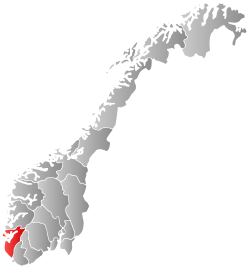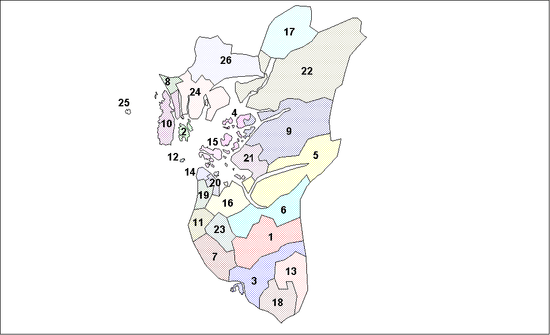Rogaland
| Rogaland fylke | ||
|---|---|---|
| County | ||
.jpg) | ||
| ||
 Rogaland within Norway | ||
| Coordinates: 59°N 06°E / 59°N 6°ECoordinates: 59°N 06°E / 59°N 6°E | ||
| Country | Norway | |
| County | Rogaland | |
| Region | Vestlandet | |
| County ID | NO-11 | |
| Administrative centre | Stavanger | |
| Government | ||
| • Governor |
Magnhild Meltveit Kleppa Centre Party (2013–present) | |
| • County mayor |
Solveig Ege Tengesdal Christian Democratic Party (2015–present) | |
| Area | ||
| • Total | 9,378 km2 (3,621 sq mi) | |
| • Land | 8,590 km2 (3,320 sq mi) | |
| Area rank | #13 in Norway, 2.82% of Norway's land area | |
| Population (2016) | ||
| • Total | 470,175 | |
| • Rank | 4 (9.02% of country) | |
| • Density | 50/km2 (130/sq mi) | |
| • Change (10 years) | 18.3 % | |
| Demonym(s) | Rogalending | |
| Time zone | CET (UTC+01) | |
| • Summer (DST) | CEST (UTC+02) | |
| Official language form | Neutral | |
| Income (per capita) | 155,000 NOK | |
| GDP (per capita) | 267,340 NOK (2008) | |
| GDP national rank | 4 (6.63% of country) | |
| Website | www.rogfk.no | |
|
| ||
Rogaland [ˈruːɡɑˈlɑn] (![]() listen) is a county in Western Norway, bordering Hordaland, Telemark, Aust-Agder, and Vest-Agder counties. Rogaland is the center of the Norwegian petroleum industry. In 2016, Rogaland had an unemployment rate of 4.9%, one of the highest in Norway.[1] In 2015, Rogaland had a fertility rate of 1.78 children per woman, which is the highest in the country.[2]
listen) is a county in Western Norway, bordering Hordaland, Telemark, Aust-Agder, and Vest-Agder counties. Rogaland is the center of the Norwegian petroleum industry. In 2016, Rogaland had an unemployment rate of 4.9%, one of the highest in Norway.[1] In 2015, Rogaland had a fertility rate of 1.78 children per woman, which is the highest in the country.[2]
The Diocese of Stavanger for the Church of Norway includes all of Rogaland county.
Etymology
Rogaland is the Old Norse name of the region which was revived in modern times. During Denmark's rule of Norway until the year 1919, the county was named Stavanger amt, after the large city of Stavanger. The first element is the plural genitive case of rygir which is probably referring to the name of an old Germanic tribe (see Rugians). The last element is land which means "land" or "region". In Old Norse times, the region was called Rygjafylki.[3]
Coat-of-arms
The coat-of-arms is from modern times; they were granted on 11 January 1974. The arms are blue with a white or silver pointed cross in the centre. The cross is based on the old stone cross in Sola, the oldest national monument in Norway. It was erected in memory of Erling Skjalgsson after his death in 1028. This type of cross was very common in medieval Norway.[4]
Geography
Rogaland is mainly a coastal region with fjords, beaches, and islands, the principal island being Karmøy. The vast Boknafjorden is the largest bay, with many fjords branching off from it.
Stavanger/Sandnes, the third-largest urban area of Norway, is located in central Rogaland and it includes the large city of Stavanger and the neighboring municipalities of Sandnes, Randaberg, and Sola. Together, this conurbation is ranked above the city Trondheim in population rankings in Norway.
There are many cities/towns in Rogaland other than Stavanger and Sandnes. They include Haugesund, Egersund, Sauda, Bryne, Kopervik, Åkrehamn, and Skudeneshavn.
Karmøy has large deposits of copper (some of which was used in the construction of the Statue of Liberty). Sokndal has large deposits of ilmenite. Rogaland is the most important region for oil and gas exploration in Norway, and the Jæren district in Rogaland is one of the country's most important agricultural districts.
History
There are remains in Rogaland from the earliest times, such as the excavations in a cave at Viste in Randaberg (Svarthola). These include the find of a skeleton of a boy from the Stone Age. Various archeological finds stem from the following times, the Bronze Age and the Iron Age. Many crosses in Irish style have been found. Rogaland was called Rygjafylke in the Viking Age. Before Harald Fairhair and the Battle of Hafrsfjord, it was a petty kingdom. The Rugians were a tribe possibly connected with Rogaland.
Culture and tourism
A series of festivals and congresses of international fame and profile are arranged, such as The Chamber Music Festival, The Maijazz Festival, The Gladmat (lit. food with a happy smile) Festival, and The ONS event, which has been held in Stavanger every second year since 1974. The ONS is a major international conference and exhibition with focus on oil and gas, and other topics from the petroleum industry. The Concert Hall and Music Complex at Bjergsted and the Stavanger Symphony Orchestra provide important inspiration in the Norwegian musical environment. Another annual event in Stavanger is The World Tour Beach Volleyball. During this tournament, the downtown is converted into a beach volleyball arena.
Rogaland is home to many natural wonders, like Prekestolen, Kjerag and Gloppedalsura. In Stavanger, there is an archeological museum with many artifacts from early history in Rogaland. An Iron Age farm at Ullandhaug in Stavanger is reconstructed on the original farm site dating back to 350-500 AD. The Viking Farm is a museum located at Karmøy.
Administrative divisions
The county is conventionally divided into traditional districts. These are Haugalandet north of the Boknafjorden, Ryfylke in the mountainous east, Jæren to the southwest, Dalane in the far south, and the Stavanger region.

Rogaland has a total of 26 municipalities:
Demographics
| Historical population | ||
|---|---|---|
| Year | Pop. | ±% |
| 1951 | 211,512 | — |
| 1961 | 239,052 | +13.0% |
| 1971 | 268,684 | +12.4% |
| 1981 | 305,490 | +13.7% |
| 1991 | 337,906 | +10.6% |
| 2001 | 375,225 | +11.0% |
| 2011 | 436,087 | +16.2% |
2021 (est.) | 525,729 | +20.6% |
2031 (est.) | 594,278 | +13.0% |
Notable residents
- Bendix Ebbell, (1865–1941), theologian, amateur Egyptologist, and Rogaland county physician from 1917 to 1935.[9]
References
- ↑ Østerud, Tor Ingar (2016-02-26). "58 percent more unemployed engineers and IT people". Norway Today. Retrieved 2016-07-23.
- ↑ "Total fertility rate, women, by county". Statistics Norway. 2015. Retrieved 2016-07-23.
- ↑ Store norske leksikon. "Rogaland" (in Norwegian). Retrieved 2016-07-21.
- ↑ "Civic heraldry of Norway - Norske Kommunevåpen". Heraldry of the World. Retrieved 2016-07-05.
- ↑ Statistics Norway - Church of Norway.
- ↑ Statistics Norway - Members of religious and life stance communities outside the Church of Norway, by religion/life stance. County. 2006-2010
- ↑ Statistics Norway.
- ↑ Projected population - Statistics Norway
- ↑ "Ebbell, Bendix". Store norske leksikon. Kunnskapsforlaget. 2007.
External links
| Wikimedia Commons has media related to Rogaland. |
| Wikivoyage has a travel guide for Rogaland. |
- Official county website
- Region Stavanger Official tourism site for the Stavanger region

